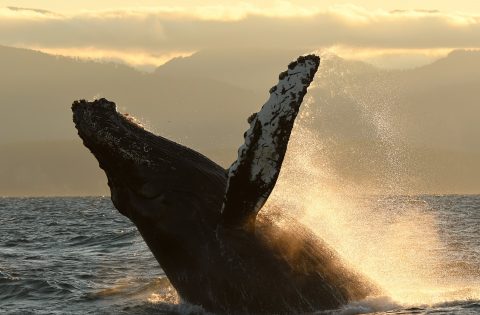Steller Sea Lion (Eumetopias jubatus)
Quick facts
- they look like great big golden grizzly bears
- range is from Washington State to Alaska
- recently have been placed on the US Endangered Species List due to rapidly declining numbers in Alaska
- it is suspected that the decline is linked with food shortages for young animals and over fishing
- breeding occurs mainly in Alaska
- males disperse after breeding season and can be found in large numbers around Victoria during the fall and winter months
- females generally stay near the breeding sites all year
- males are about 3 m (10 ft ) long and weigh approx. 900 kg (2000 lbs)
- males eat about 5–10kg (11–22 lb) fish daily
- females are substantially smaller, approx. 400–450 kg (800-900lbs)
- feed on salmon and small schooling fish
Description
The Steller sea lion, also known as the northern sea lion, is the largest of the Otariidae (eared seal) family. Adult males measure 2.8–3.2 m (10 ft) in length and weigh an average 566 kg (maximum 1120 kg/2,200 lbs). Females reach 2.9 m (7 ft) in length, and 263 kg (maximum 350 kg/600 lbs) in weight. Adult coats are a light tan to reddish-brown color, usually slightly darker on the chest. The life span of male Steller sea lions is 20 years, females 30 years.
Range and habitat
In 2000, Steller sea lions was estimated to have a global population of about 85,000: a decline of more than 50% since 1960 when an estimated 240–300,000 Steller sea lions lived worldwide. This sea lion can be found from the North Pacific Ocean from California to northern Japan. There are two distinct populations separated by genetics. The western population, which lives in the Gulf of Alaska, Bering Sea, Russia and small numbers in Japan, and the eastern population, which lives anywhere from California, to Oregon, British Columbia, and Southeast Alaska. A little closer to home, we can find fantastic haul out sites at Race Rocks and Whale Rock (San Juan Island, WA).
Feeding behaviour
Steller sea lions forage near the shore for fish such as pollock, herring, capelin, mackerel, rockfish, and salmon; and cephalopods such as squid and octopus. They have been known to eat Northern fur seal pups and harbour seals on occasion. Predators include sharks and orca. Although they are not typically deep divers, one individual has been observed diving to a depth of over 400 m (1320 ft).
Reproduction
Female Steller sea lions reach sexual maturity between 3–8 years, males between 3–7 years, however males do not become territorial until they reach 9–13 years. Breeding season lasts from mid-May to mid-July. Dominant males arrive early to establish territories on the breeding rookeries on exposed rocks and beaches. These rookeries often have adjoining haul out sites and some rookeries are used as haul out sites when breeding season is over. Females give birth about three days after arriving at the rookery. Steller sea lion pups are born measuring about one metre (3.3 ft) in length and weighing 16–23 kg (50 lbs) with a thick, dark-brown coat that will be shed in 4–6 months for a lighter brown coat. About nine days after giving birth, females begin a feeding cycle alternating between 1–3 days feeding at sea and 1–2 days nursing her pup on land. Closer to weaning, the mother spends more time feeding at sea. The average nursing period is one year, however Steller sea lions have been known to nurse up to three years. Females mate about 11–14 days after giving birth. Breeding season is followed by molting season. Females molt in early autumn followed by males in late autumn. Juvenile and non-breeding Steller sea lions molt in July and August.
Comments
Although the eastern population has remained stable at an estimated 39,000 for the last few years, the western population of Steller sea lions has been declining rapidly. In 2000, there were only about 45,000 Steller sea lions left in the western population. The cause of the decline in the western population of Steller sea lions is unknown. One theory is that food resources have declined as commercial fisheries have increased fishing for ground fish. This theory is a result of the fact that 50–80% of trawl fishery catches in the US have been caught in the sea lion’s habitat and consists largely of sea lion prey. For example, in December 1998, an official US government biological opinion concluded that walleye pollock fishing off the coast of Alaska would deplete that species enough to jeopardize the continued existence of the western population of Steller sea lions.
In December 2000, another report concluded that competition with fisheries that target Steller sea lion prey in the Bering Sea, Aleutian Islands, and Gulf of Alaska is also a significant factor in population decline. Continued fishing for groundfish at current quotas such as: pollock, Atka mackerel, and Pacific cod, are also likely to jeopardize the western population of Steller sea lions. Commercial hunting of Steller sea lions ended in the 1970s. This species is also at risk of entanglement in commercial fishing nets, which kills an estimated average 30 sea lions yearly. At the southern end of the Steller’s sea lion range, population numbers have also been declining in recent years likely due to reduced prey availability, environmental contamination, and disease. Climate change also threatens these animals. The 1997–98 El Niño may have affected Steller sea lions in Alaska although it is not known yet to what extent. Warmer temperatures in the Bering Sea alter ocean currents and atmospheric conditions, which may also be affecting the species. A number of Steller sea lion haul out and rookery sites were affected by the Exxon Valdez oil spill in Prince William Sound, Alaska, in 1989 but it is unknown whether the spill impacted the population.






